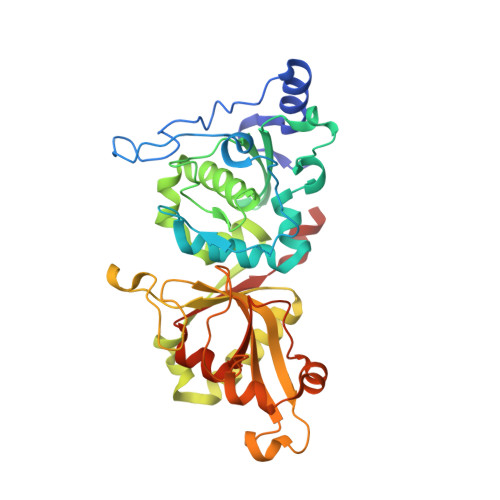Structural Insights into the Unique Activation Mechanisms of a Non-classical Calpain and Its Disease-Causing Variants.
Velez, G., Sun, Y.J., Khan, S., Yang, J., Herrmann, J., Chemudupati, T., MacLaren, R.E., Gakhar, L., Wakatsuki, S., Bassuk, A.G., Mahajan, V.B.(2020) Cell Rep 30: 881-892.e5
- PubMed: 31968260
- DOI: https://doi.org/10.1016/j.celrep.2019.12.077
- Primary Citation of Related Structures:
6P3Q - PubMed Abstract:
Increased calpain activity is linked to neuroinflammation including a heritable retinal disease caused by hyper-activating mutations in the calcium-activated calpain-5 (CAPN5) protease. Although structures for classical calpains are known, the structure of CAPN5, a non-classical calpain, remains undetermined. Here we report the 2.8 Å crystal structure of the human CAPN5 protease core (CAPN5-PC). Compared to classical calpains, CAPN5-PC requires high calcium concentrations for maximal activity. Structure-based phylogenetic analysis and multiple sequence alignment reveal that CAPN5-PC contains three elongated flexible loops compared to its classical counterparts. The presence of a disease-causing mutation (c.799G>A, p.Gly267Ser) on the unique PC2L2 loop reveals a function in this region for regulating enzymatic activity. This mechanism could be transferred to distant calpains, using synthetic calpain hybrids, suggesting an evolutionary mechanism for fine-tuning calpain function by modifying flexible loops. Further, the open (inactive) conformation of CAPN5-PC provides structural insight into CAPN5-specific residues that can guide inhibitor design.
Organizational Affiliation:
Omics Laboratory, Department of Ophthalmology, Byers Eye Institute, Stanford University, Palo Alto, CA 94304, USA; Medical Scientist Training Program, University of Iowa, Iowa City, IA 52242, USA.

















